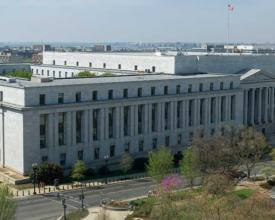DHA eNews – What You Need To Know About The Budget Reconciliation Bill
Last week, I had the great pleasure of meeting with members and hearing many expert speakers at DHA's 104th Annual Meeting. It's amazing to think that DHA has held that many annual meetings. I'm pleased and proud to help lead this great industry. I also had the pleasure of recognizing many long-term members who have led the industry for decades.
To improve outcomes for our industry, we must solve the challenges posed by unfair competition from Asia. Our members have been damaged by below-cost imports that have led to mill closures. At our annual meeting, we heard from Betsy Natz, CEO of the Kitchen Cabinet Manufacturers Association, about the threat from unfair trade to their industry that has led to capacity utilization rates as low as 30%. DHA continues to advocate for better trade practices and supports the national security Section 232 investigations of wood product imports. Hopefully, we will have some good news about trade policy in the future with 232 and other actions.
If you have questions or comments, contact me. I look forward to hearing from you.

Keith A. Christman, President

At this writing, the budget reconciliation bill has passed the U.S. House of Representatives. The bill extends provisions of the Tax Cuts and Jobs Act of 2017. As it stands, the bill will allow 100% bonus depreciation through January 1, 2030, and the estate and gift tax exemption amount and the generation-skipping transfer tax exemption would be permanently increased to $15 million.
These provisions are important to businesses in our industry. Bonus depreciation encourages more investment, and estate tax exemptions make it easier to transfer the ownership of family-run businesses to the next generation.
PHOTO © ARCHITECT OF THE CAPITOL
DHA joined allied organizations in a letter to Congressional leaders opposing the limitation of the business state and local tax deduction (B-SALT). These taxes are not optional for businesses; they are ordinary expenses that a business must pay. To date, these limitations are not included in the House budget reconciliation bill.
On May 12, the U.S. and China announced a cooling of the ongoing economic dispute by mutually reducing tariffs on goods traded between the two countries for 90 days, with the expectation that negotiations will continue. The U.S. will reduce tariffs on Chinese goods to 30%, down from 145%. China will drop U.S. tariffs from 125% to 10%.
The bipartisan Solid American Hardwood Tax Credit Act would allow individual taxpayers to include solid American-manufactured hardwood products—such as flooring and paneling—as qualified home energy efficiency improvements under the Energy Efficient Home Improvement Credit.
As of this writing, the Natural Resources Committee part of the budget reconciliation bill includes provisions that direct both the U.S. Forest Service and the Bureau of Land Management to increase timber harvesting on the lands they manage by 25%. The Hardwood Federation will push to keep this as part of the tax bill as legislators move forward with the budget reconciliation process.
The EPA and Army Corps of Engineers have been holding listening sessions to get input on the definition of “waters of the United States” (WOTUS) under the Clean Water Act. Organizations like the National Association of Home Builders seek to improve the permitting process and develop a definition of WOTUS that complies with the Supreme Court's Sackett decision, which limited federal jurisdiction.
The Financial Times recently reported on the EU Deforestation Regulation (EUDR), emphasizing key concerns of those in the U.S. forest products supply chain and how the flaws in the EUDR make it nearly impossible to comply with the regulation. While the article suggests that the U.S. will be categorized as "low risk," U.S. companies will still be required to comply with fiber geolocation and traceability.
Stakeholders in the forest products industry stated that new guidance documents for the EU Deforestation Regulation do not relieve its onerous regulatory burdens. "The EU Commission's latest guidance documents neither address severe EUDR compliance challenges that continue to threaten U.S. forest products exports, nor provide any legal compliance certainty. In addition, the Commission’s latest updates appear to disproportionately benefit EU supply chains."
A three-judge panel at the U.S. Court of International Trade recently heard arguments in one of several challenges to the tariffs imposed on April 2. The suit was brought by several small businesses and focuses on "reciprocal" tariffs imposed under the International Emergency Economic Powers Act.
U.S. imports of hardwood plywood soared by 30% in March. Imports of hardwood flooring and assembled flooring panels both rose by more than 20%. Imports of hardwood moulding grew by 26%.
About a year ago, yet another Montana sawmill closed its doors. Now, Montana lawmakers have passed a bill to create a low‑interest loan program for companies that reopen mills, to help boost Montana's economy and forest health.
For decades, the U.S. has imported a significant amount of the timber it needs. Canada is its largest supplier, providing about 30% of U.S. softwood lumber and oriented strand board (OSB) and 14% of softwood plywood. Experts conducted research to determine whether U.S. federal lands have enough timber to meet the country's needs and identify constraints.
The first-ever Sustainable Biomass Program regional risk assessment for national forestlands has been finalized and approved by biomass producers. The risk assessment provides a comprehensive framework for sustainable biomass sourcing across all forests administered by the U.S. Forest Service in the contiguous United States.
Forests are typically thinned to help prevent forest fires and restore forests to a more natural state. Thinning can also create more mountain runoff to help areas like the central Sierra Nevada region that rely on snowpack. During drought years, when it’s needed most, runoff increases by 8–14% from thinned forests.
Just how old is the U.S. Forest Service?





